Serendip is an independent site partnering with faculty at multiple colleges and universities around the world. Happy exploring!
BSIE 2010: Session 9

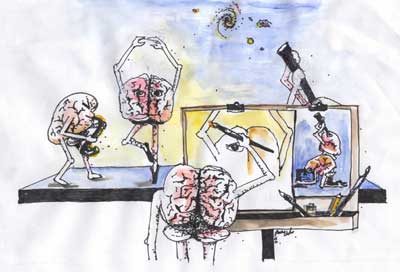 |
Brain, Science, and Inquiry-Based Education
|
 |
Picking up from yesterday
we should be just as concerned about the student who is fixated on monopolizing the conversation or discussion, similar to way we are concerned about that student who appears to be fixated on making no comment at all. The "talker" may not be open about, or aware as to why he has the need to dominate, while the non-talker may not be aware of just what is needed to make him feel more as an active talking participant within the group. Changes are needed by both ... Mattie
People will move out of their comfort zone when they feel valued ... Geneva
The topic of students who were unwilling to conversate was brought up ... I thought it was interesting how Paul described this as ... they are being inhibited by something.I feel forming relationships with my students is very important. Walls come down ... Ashley
these molecules did not get in the order nor were they placed in this order, rather the order was an accident of trying different possibilities. The arrangement we see now is the one that worked. We don't know how many different variations existed that did not survive ... Susan
Social ideas, stereotypes, norms, and values are culturally constructed. This being the case, I feel that it is extremely interesting to consider the implications for learning and information gathering ... Keith
The brain: bringing the threads together
Conversation: valuable sharing of differences to create, individually and collectively, new explanations/stories/constructions (looping)
Science/empirical inquiry: valuable testing of expectations based on summaries of observations/explanations/stories with observations to create, individually and collectively, new explanations/stories/constructions (looping)
Evolution: exploration of possibilities driven by randomness (trying new things out) and influenced by what works at any given time; trying things out together with interaction/conversation (looping) itself creates new possibilities/constructions
The brain as a constructor? Using randomness, trying things out to see what works? Having/sharing differences to create new possibilities/constructions? Working individually and collectively? Always exploring unless inhibited? Where do thoughts one doesn't think one has come from?
Contra Descartes, not a brain and a mind but ... a brain
- Emily Dickinson (1830-1886)
- Francis Crick, 1995: The Astonishing Hypothesis: "a person's mental activities are entirely due to the behavior of nerve cells ... and the atoms, ions, and molecules that make them up and influence them".
- V.S.Ramachandran, 2003: " it never ceases to amaze me that all the richness of our mental life - all our feelings, our emotions, our thoughts, our ambitions, our love life, our religious sentiments and even what each of us regards as his own intimate private self - is simply the activity of these little specks of jelly in your head, in your brain. There is nothing else"
- Paul Grobstein, contemporary: "Brain = behavior, there isn't anything else."
- Behavior can be altered by altering the nervous system
- Traumatic brain damage
- Surgery, drugs, and ... ?
- Epilepsy as an instance
- Lots of aspects have behavior, even quite sophisticated ones, have "material" feel about them
- Surprising and quite sophisticated things can emerge from interactions of simple elements (of which the brain/nervous system is an example, as we'll see).
- It isn't that anything "disappears" as one discovers things related to the brain but rather that the Brain gets "wider"
- Disadvantages?
- Advantages:
- we can ourselves create new understandings of the world, individually and collectively
- would make the unobservable (the unconscious) observable?
The "real" nervous system - different if behavior different?
- Among different kinds of organisms?
- Among different individuals? within individuals over time? - New imaging techniques
- Notice that differences leave open the question of what causes differences (genes, experiences, activity, culture, etc)
- Implies that "information" can alter matter; not mysterious, "info" turns out to be perturbations of matter organization in neurons, can via metabolic processes influence organization/properties of neurons
- Why the diversity? Is there a "best" nervous system or .... ?
The brain itself as an explorer/creator
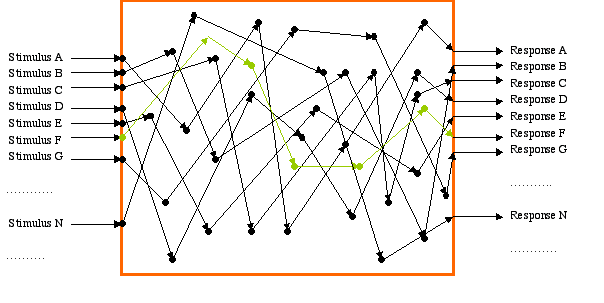 |
The sphaghetti (switchboard, "reflex") box model
Virtues
|
Problems of reflex model
Harvard Law of Animal Behavior
"Under carefully controlled experimental circumstances, an animal will behave as it damned well pleases"
Divergence and convergence
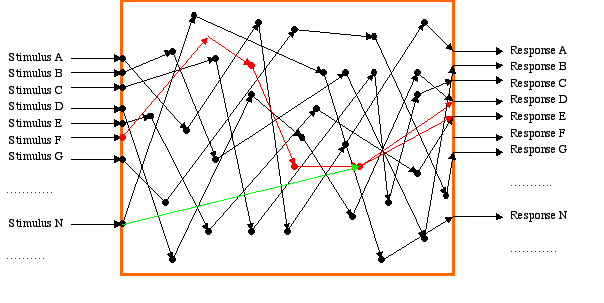 |
Sphaghetti (switchboard, "reflex") plus box model
Virtues
|
A rethinking - boxes in boxes
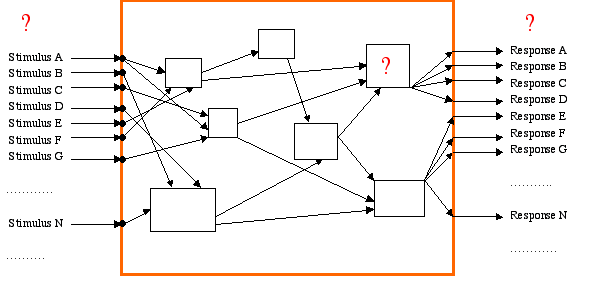 |
The sphaghetti (switchboard, "reflex") box model
Virtues
|
Facing up to the stereotopy, stimulus-response problem ... freeing the box from the outside world, adding autonomy


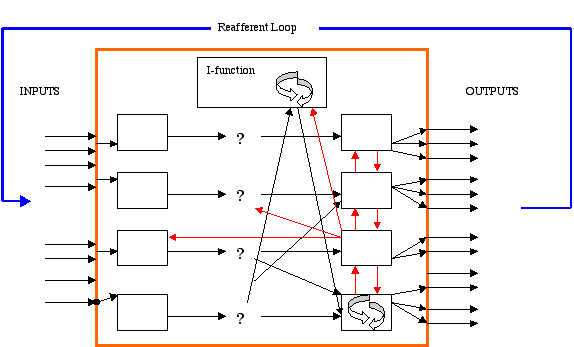
Diversity from combination/organization/interaction/conversation - every brain a unique exploration of possibilities
The "real" nervous system - an input/output box consisting of interconnected input/output boxes?
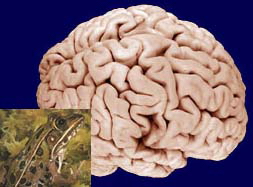 |
 |
| photo from Kemali and Braitenberg, Atlas of the Frog Brain, Springer-Verlag, 1969 |
Caudal to rostral sequence of "boxes" of "central nervous system" originates in neural tube development, is commmon to all vertebrates
(will defer to later discussion of invertebrates, variations among vertebrates)
Each box in turn (somewhat arbitrarily) subdividable into smaller boxes (with some differences among vertebrates, to return to)
And those ... yes, "its boxes all the way down"


The smallest box: neurons everywhere
Invertebrate nervous systems also have neurons, but differently arranged - makes sense?
Neuron as common, smallest box and as input/output element, connected to other boxes
- Cells, like other cells, but specialized to receive/process transmit "information" (as opposed to matter or energy)
- Size scale - tens of microns (10-6) meters)
- Larger boxes must differ in how smallest interconnected
- Relevance of numbers? enough to "account for all the uniqueness that exists among people"? ... 1012exp1012 possible nervous systems?
- Differences between people, differences between organisms due to .... not building blocks but assembly (architecture)
- Need to know how neurons work - to return to
Can use boxes->boxes ... ->boxes(neurons) to show that larger boxes interconnected, in relatively specific ways (anatomical specificity) and to rigorously specify "input" and "outputs" of largest box ... nervous system itself
- grey matter (soma, dendrites, pre-synaptic terminals, neuropil) vs white matter (bundles of axons, tracts)
- central vs peripheral nervous system (some ganglia, but largely axon bundles
- output elements of nervous system (motoneurons, plus) = neurons with axon terminating outside nervous system
- input elements of nervous system (sensory neurons, plus) = neurons with receiving surface (dendrites) outside of nervous system
- everything else = interneurons
- numbers/proportions: more reason to think of ns as "semi-autonomous"
So ... at least parts of our box within box model real ... and helps define "input" and "output" more rigorously
Implies: different regions on brain, different brains, different behaviors largely because of different assemblies of similar elements ("architecture")
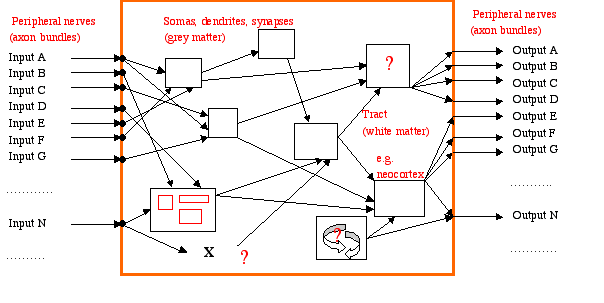
Topographic organization - anatomical specificity (input and output locations)
Outputs - (myotomes)
- Motoneurons located at levels of neuraxis related to location of muscles controlled
- Each motoneuron activates only one muscle
- Implications:
- "action" is not one output but pattern of activity across lots of them - "motor symphony"
- source of lots of additional variation in behavior
- lots of outputs/nervous system involved in any "action", is "distributed" characteristic
- need to understand how patterns of activity created, parts coordinated
Inputs - (dermatomes)
- Sensory neurons terminate at levels of neuraxis related to location of receptors
- Implications
- "sensation"/"perception" not one input but pattern of activity across lots of them (across modalities and, as will be seen, in one modality - another "distributed" characteristic
- need to understand how inputs combined
- thought = pattern of activity across lots of neurons
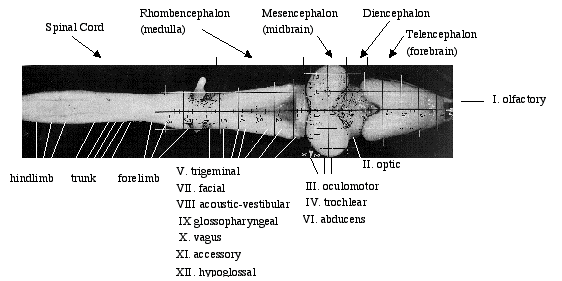 |
For additional information: |
Brain a distributed system, works by interaction/conversation among boxes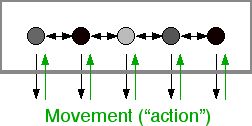
Usefulness of the interconnected box model and ... another box?
- Capabilities of spinal cord
- Quadriplegia (slightly better) - relevance of topographic organization
- Christopher Reeves and ... , from NIH
- The "I-function"
Observations "surprising", but have to be accepted - Issue is "how to make sense of them"
Two kinds of behavior ("reflex" versus something-else) intuition probably not useful
- Spinal cord capable of very sophisticated activity
- Brain capable of quite unsophisticated activity
- Distinction between "reflex" and other things?
- "foot withdraws when irritated" - spinal cord capable of sophisticated activity on own
- is ok ... given topography and "physical contiguity principle ("PCP")
- "person doesn't say ouch when foot irritated" - behavior frequently depends on linking paths within nervous system
- is ok ... given topography and "physical contiguity principle ("PCP")
- "person doesn't move foot when hearing (or reading) request to do so" - behavior frequently depends on linking paths within nervous system
- is ok ... given topography and "physical contiguity principle ("PCP")
- "person says foot irritation not felt/experienced" - behavior frequently depends on linking paths within nervous system
- is ok ... given topography and "physical contiguity principle ("PCP") AND ..
- "behavior" can occur without it being experienced by the behaving organism AND ...
- neuronal circuitry adequate to support "feeling/experiencing" (I-function) is in the brain (spinal cord not needed for this function)
- Where is Christopher Reeves? Is he paralyzed? Does he feel pain? - has to do with "mind", "self", "soul", "personality", "consciousness" ?
- words requiring redefinition in light of new experiences/observations?
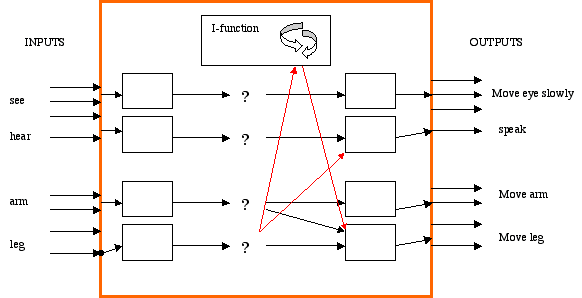 |
Ascending somatosensory pathways Descending motor pathways
|
The bipartite brain
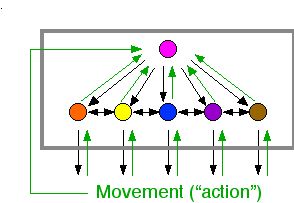

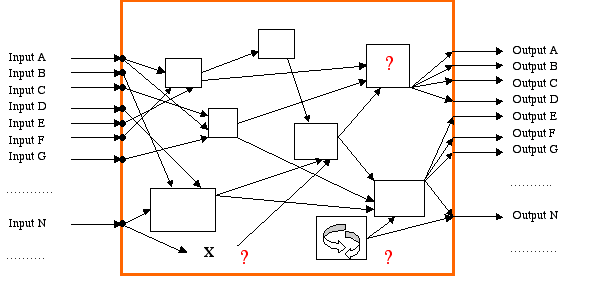


Comments
Against all odds: Learning can take place
Highly stimulated after Friday's discussion and the days leading to it, I felt in the mood this weekend for good film. On Saturday, I saw Inception, a film I discussed in a different comment. Sunday, I rented, "Slumdog Millionaire," a film I wanted to see but missed. The hero of the screenplay is a boy who, against all odds, learned enough from the living of dangerous, impoverished childhood and adolescence enough to win 2 million rupees in his nation's TV game of, "Do You Want to be a Millionaire." He was judged incapable of such a feat and so tortured until it became clear to his abusers
I completed this comment and then lost it while editing in preview mode. I will try to recreate a hours worth of work.
Inception: Conscious and Unconscious
We settled in our seats to watch a film we knew nothing about except that the movie was getting strong positive reviews. That was my last independent thought as the film progressed at lightning speed. I will leave the story line and special effects for you to enjoy as I did without advanced notice. What I want to discuss is the enormous feeling of deja vue I felt exiting the theatre. The screenplay delved into the relationship between the conscious and unconscious brain. There were vivid examples of the brain as a "constructor." There were "shared differences to create new possibilities working individually and collectively." The brains were "always exploring unless inhibited." They were "trying out things together with interactions and conversations" that created "new possibilities and constructions." The quotes surround phrases that I copied from the conversations among Paul and the members of our group during Session 9. The film, Inception, was a visualization of Friday's conversation and summaries offered by Paul. It was the perfect way to follow up and extend Friday morning's discussion.
This morning we started with
This morning we started with a review of people's comments. Essentially we learned that when people feel a sense of value they will talk and engage in the classroom more. One can lead good conversation and good conversation is good for everyone. This is because everyone will come with their own ideas and these ideas will be shared and learned with each other.
Trying different things in the classroom and in conversation is very important..."trying out" is very important.
The most important thing that I learned today is not to ask the student "why are you doing this" Rather, tell the child or let them know that what they are doing wrong and ask them to please stop. It is also important, when talking with children, the voice that you use. You don't want to seem as though you are yelling at them or saying it too negatively (in a negative tone). It's not fair to judge the student by the way they are acting, just let them know what they are doing is wrong, not asking questions...
Our brain is very different from one another and the brain is always in a process of changing. We tend to learn more when we are active and engaged learners. That's why as a teacher it is important to put our maxiumum effort to make the student active because our input will create output.
Brain Changes
I loved Susan's metaphor- How if enough people walked on a certain area of grass, a new path will be form. The brain forms new pathways with different experiences/thoughts/inputs. The pathway becomes "stronger" with the repetition of these experiences/thoughts/inputs".
While we did not yet discuss how age changes the brain, I am already have many questions. What steps can a person take to minimize the effects of aging? If a brain has shrunken due to age, disease , etc. can it go back to its orginial size with intervention? Is it true that weight gain can cause the brain to shrink?
Post new comment